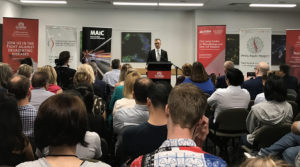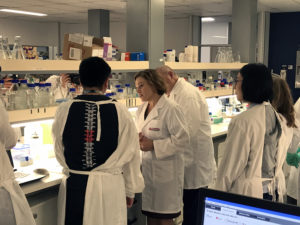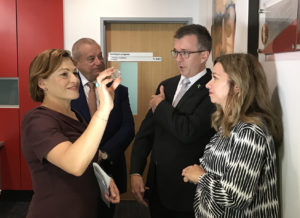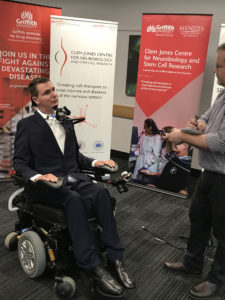World-leading Griffith University research into the development of a cell-based therapy for treating spinal cord injuries has received a $5.7 million boost from the Queensland Government.
Deputy Premier and Treasurer Jackie Trad, who announced the funding at the Griffith Institute for Drug Discovery at Nathan campus, said it would support pre-clinical research initially pioneered by Australian of the Year Alan Mackay-Sim and follows initial funding for the project announced in 2017.
“It essentially doubles the government’s investment in this project which has already led to a number of patient outcomes relating to nerve repair around the spinal cord,’’ she said.
“This has also opened up the potential application to other parts of the body affected by peripheral nerve injury including the brain.”

Associate Professor James St John at the funding announcement
Project lead Associate Professor James St John said the Spinal Injury Project (SIP), which came to life with funding support from and continued lobbying by the Perry Cross Spinal Research Foundation, was based at the Clem Jones Centre for Neurobiology and Stem Cell Research and focused on developing an easily available, affordable and accessible treatment for all patients with spinal injury.
“In Australia this represents more than 15,000 people and hundreds of thousands globally,’’ he said.
“We have been fortunate to have exceeded our own initial expectations and can now create much larger, more robust nerve bridges than we had first thought. It is clear that cell bridges improve cell survival and regeneration.
“We are reinventing and rethinking how cells can grow, which allows us to create new cell products never before thought possible. The next funding period will enable us to expand this technology and drive it to clinical trial.”
Griffith University Vice Chancellor and President Professor Carolyn Evans said Griffith was proud to support this pioneering research, attracting significant investment in spinal research to get closer to the clinical application.
“Griffith has been investing in research into spinal cord repair for two decades and we are committed to continuing the legacy of Professor Emeritus Alan Mackay-Sim in the endeavour to find a breakthrough in this important area,” she said.

Deputy Premier Jackie Trad chats to Dr Mo Chen about their ground-breaking research being undertaken in the GRIDD lab
More than 30 people are currently working on five key streams of the SIP initiative, undertaking research into different elements of the development of a cellular therapy concurrently. The team includes PhD candidates and research staff from 17 countries with work carried out at Griffith facilities on the Gold Coast and in Brisbane.

Deputy Premier Jackie Trad holds up a cellular nerve bridge with Associate Professor James St John and Associate Professor Jenny Ekberg
“What makes our job even more exciting is working with brilliant young scientists such as Dr Mo Chen who can create incredible cellular nerve bridges,” said Associate Professor Jenny Ekberg from Menzies Health Institute Queensland.
“It is almost every day that we get new breakthroughs that help us keep pushing the boundaries.
“The potential is that we will be able to repair nerves not just in the spinal cord but also in peripheral nerves and give hope to many Australians who suffer from debilitating injuries of the nervous system.”
Associate Professor Ekberg describes Dr Chen as a bioengineering genius who creates three-dimensional cell constructs using a newly invented technology involving 3D printed templates.
“The actual process cannot be revealed as a patent application is pending,” she said.
“The talented scientists in our team are exactly the sort of people Queensland needs to keep and thanks to this additional MAIC funding, we are able to retain their incredible expertise that is key for this important work,’’ said Associate Professor St John.
The team also includes a robotic system for rapid screening of compounds to find potential drugs that can enhance the cell transplantation therapy.
“We have been busy screening thousands of compounds, looking for those that that can stimulate cells to grow,” Associate Professor St John said.
“This drug discovery involves using the robotic system to screen hundreds of compounds each day. Five years ago, everything had to be done manually, which meant we could only screen a few hundred compounds each year. Modern technology can now rapidly advance our scientific discoveries.”
Associate Professor St John said while scientifically exciting, the project was about much more than just science.
“We are also working out ways of translating this therapy so it can actually be delivered in the clinic,” he said.
“We want to investigate and be able to recommend how long-term intensive activity-based rehabilitation can bring great benefits to people living with chronic spinal cord injury. Currently, easy access to this sort of rehabilitation is not available in Australia.
“Critically important for the success of the trial is that it is co-designed with the people with live with spinal cord injury.
“The Perry Cross Spinal Research Foundation has been vital in these investigations, helping us reach patients, carers and patient interest groups in Queensland, NSW and Victoria who can also help us progress the research.
“We are conducting surveys of the spinal cord injury community and we’re also working with groups like Spinal Life Australia and Catwalk Trust in New Zealand to learn from their experiences, which will help to shape the therapy in a way that benefits most patients.”

Perry Cross, head of the Perry Cross Spinal Research Foundation, being interviewed by the media at the funding announcement.
Spinal cord injuries reportedly cost the Australian health care system a million dollars per year per patient.
Associate Professor St John said the potential saving to a burdened health care system was substantial but restoring function to people living with significant disability was their primary goal.
“Simple things can change lives,” he said.
“Spinal cord injury is complex with every injury causing different levels of paralysis. It is therefore hard to predict the outcomes for each patient.
“But what we know is that at least some of the neural connections can be restored. This may mean that it could potentially restore the use of someone’s fingers or hand, making it possible to feed themselves or drive a car — daily activities you and I take for granted.
“It may also mean they could regain the ability to feel which could reduce the incidence of pressure sores.
“What is clear is the regeneration will occur over considerable time and for this reason we need to enable the recipients of the cell transplantation to have access to long-term intensive rehabilitation.”
The Spinal Injury Project has a number of funding sources, including key partner The Clem Jones Foundation and The Perry Cross Spinal Research Foundation.
